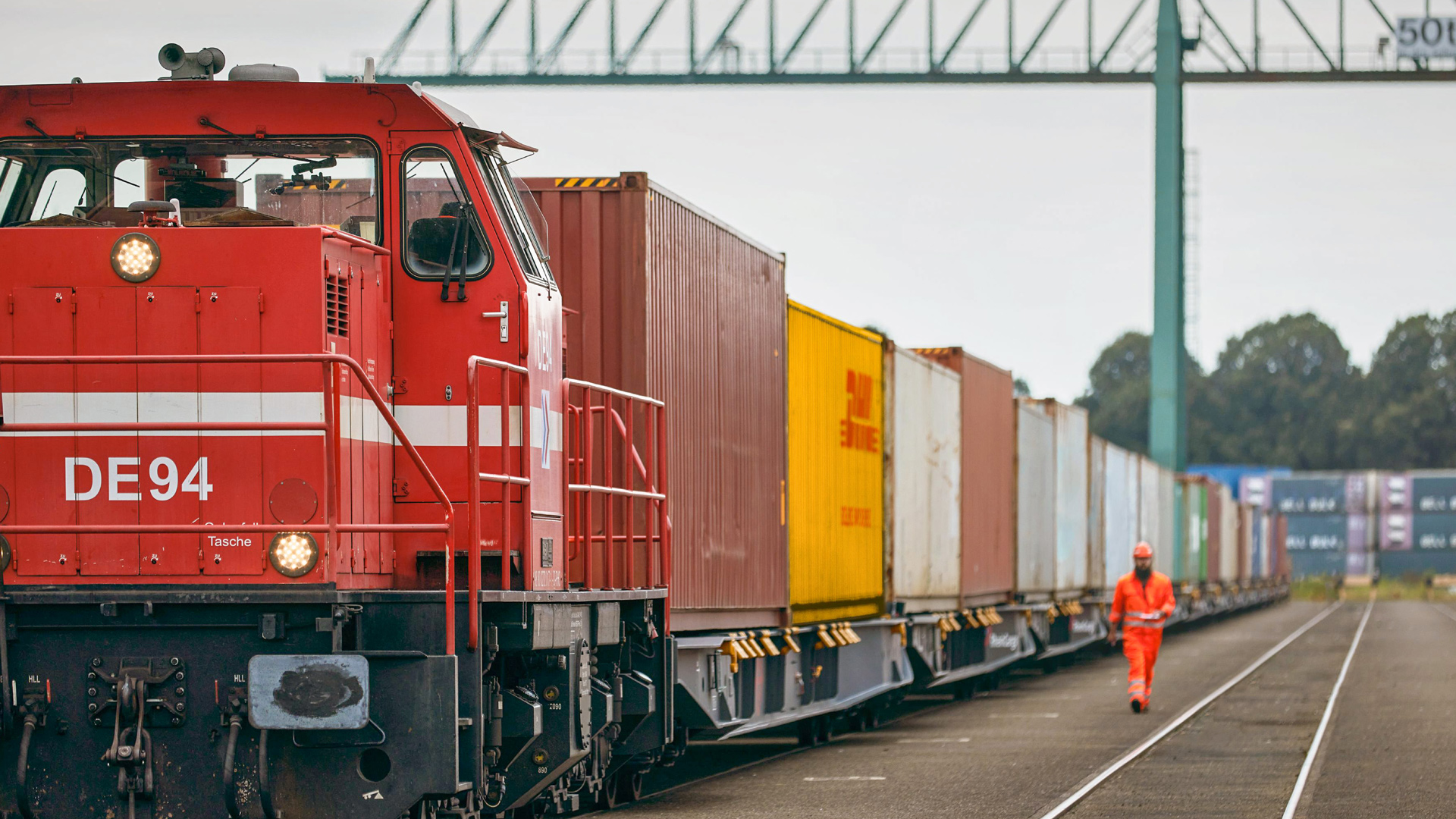
It is generally agreed that rail’s great asset is its environmental sustainability. This is why people tend to think of rail freight in terms of advantages rather than disadvantages. Rail freight is considered the land transport mode of the future. For companies, however, aspects such as reliability, loading capacity and transport speed are also crucial in addition to the carbon footprint. Where rail scores – and where it does not – is compiled in our overview.
Rail and Road Freight: Competition and Mutual Supplementing
The two competing modes of overland transport are rail freight and road freight. Inland shipping, with its very limited route network of navigable rivers and canals, plays only a secondary role as an alternative to land transport. But it is too short-sighted to regard road and rail only as competitors. They can also complement each other in intermodal transport concepts. Whereby “can” is hardly an apt description for most cases – often, road can not only complement rail, it actually has to do so: This is at least the case if the destination of the shipment is not connected to the rail network or whenever the rail system is overloaded.
This addresses one disadvantage of rail in advance. In the following, further cons and pros of rail transport are compiled, not only to present the ecological balance of rail as the biggest plus, but also to facilitate the decision in which cases which mode of transport is best suited.

Advantages of Rail Transport
Fewer Greenhouse Gas Emissions Equals Greater Sustainability
E-mobility is already predominant in rail transport. In Europe, around 80 percent of all freight train kilometers are covered electrically. This means that even now there are very few direct emissions. In the future, when the proportion of green electricity used to power locomotives gradually increases, net zero emissions from freight trains will be possible. At present, rail transport emits less than one-fifth of the greenhouse gases caused by road transport per ton transported and kilometer traveled. However, this is not only due to the drive system, but also to the better ratio of transport volume and necessary operating power.
Efficiency Thanks to High Cargo Capacity
Speaking of transport volumes, freight trains can ship more, larger, and heavier goods than trucks. On long-distance routes, this can be efficient not only ecologically but also economically. A large number of full container loads is possible in block train transport – i.e., the train transports only a single load without being split up en route. And in addition to full container loads (FCL), less-than-container loads (LCL) are also an option in wagonload freight.
Safety
The risk of a rail accident is around 40 times lower than for road transport. This results in a significantly lower failure rate for shipments. And with the few accidents on rail, there is also less risk of total loss, which frequently occurs after accidents with trucks on the road.
Furthermore, there is a lower risk of theft. There are very practical reasons for this: trucks in parking lots are easier for thieves to reach and, above all, easier to unload than freight cars in the rail bed. You cannot simply park next to the wagons and reload containers.
Plannability
Construction sites and unforeseeable incidents occur with every means of transport. On rail lines, signals can fail or track switches can be disrupted. At least trains cannot get stuck in sudden traffic jams like road freight, because line capacities are regulated by timetables. Therefore, short-term delays are rarer.
Intermodality
Standardized containers and trailers can be transported both by road and rail. This dispenses with the need for time-consuming reloading. The containers or trailers are simply lifted from the train onto the truck or vice versa. Transloading between freight trains and container ships is also quick if the port infrastructure is adequate. The intermodal potential compensates for the disadvantage that not every industrial park has a rail connection.

Disadvantages of Rail Transport
Low Level of Flexibility in Terms of Time and Location
The high degree of plannability in train transport has a downside: limited flexibility. A freight train must stick to the timetable and cannot depart spontaneously to carry out an unexpected delivery order. Thus, the train is inflexible in terms of time.
In addition, the freight train can only access locations with rail sidings – trucks are still indispensable for door-to-door transport. This also makes the train less flexible in terms of location than road freight.
Transport Costs
Charges for the utilization of tracks are often higher than those for the use of roads. This translates into freight rates being usually higher than the cost of road freight.
Noise Emissions
Anyone who has ever heard a freight train rush past knows what is meant. No doubt trucks also make noise - but it cannot be compared with the noise of a train at full speed. When tracks run through the middle of a community, this is especially problematic for residents. Whisper rails and noise barriers can help, but they are further price drivers.
Non-uniform Standards
National regulations and divergent technical standards even for track width are (still) unnecessarily slowing down rail transport at country borders. A change of train driver or even the locomotive may be necessary, while on the road the entire delivery can be carried out by one single person in one single vehicle.
Infrastructure in Need of Expansion
Moreover, the underdeveloped rail infrastructure is a stumbling block for rail freight. Only as many trains can run as the rail network allows. This can lead to unwanted waiting times. As the infrastructure in many countries is not only limited but also outdated, urgently needed maintenance work on the rail network adds to the expansion measures in many places. Repair work further restricts the already scarce rail capacities and extends transport times, while unexpected damage to bridges or signal boxes can lead to train cancellations.
Take one example from Germany: The original goal was to substantially expand the rail infrastructure by 2030 to carry twice as many people per year to their destinations through coordinated and reliable local, long-distance, and freight connections. At the beginning of March, a new prognosis was made: 2070.
Conclusion
The ecological benefits of rail freight provide companies with the opportunity to reduce their own ecological footprint through their shipments – however, this may be associated with longer waiting times, higher freight rates, and a certain degree of inflexibility. For this reason, road freight will continue to be irreplaceable as the most flexible mode of transport for many transportation needs.
Frequently Asked Questions
- What are the advantages of rail transport?
Rail is sustainable – compared with trucks, it produces only about one-fifth of the emissions per kilometer traveled and ton transported. At the same time, due to its largeer cargo capacity, it is efficient, mostly punctual, and ideal for intermodal use in combination with road freight. And: the risk of an accident and a resulting total loss is comparatively low. - What are the disadvantages of rail transport?
Non-uniform standards in legal requirements and technical equipment, and an infrastructure in need of expansion often dampen the euphoria – especially when it comes to cross-border train services. And: in most cases, rail alone is not sufficient, as the destinations are often not connected to the rail network. Reloading the goods onto a truck is often necessary.



